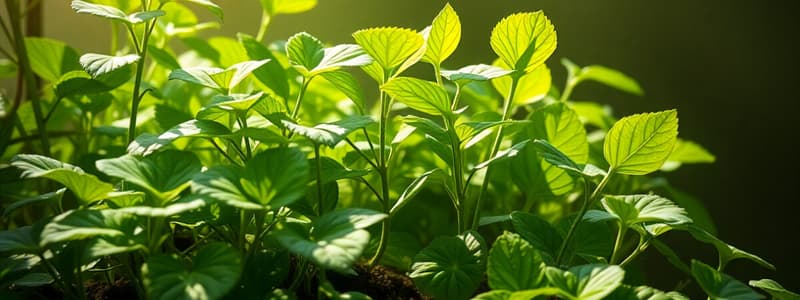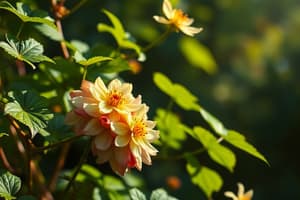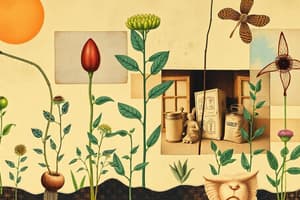Podcast
Questions and Answers
Which process directly involves the use of energy to move molecules against a concentration gradient?
Which process directly involves the use of energy to move molecules against a concentration gradient?
- Facilitated diffusion
- Active transport (correct)
- Osmosis
- Passive diffusion
In cellular respiration, what is the primary role of oxygen?
In cellular respiration, what is the primary role of oxygen?
- To directly break down glucose
- To facilitate the process of glycolysis
- To produce carbon dioxide
- To act as the final electron acceptor in the electron transport chain (correct)
How does the process of meiosis contribute to genetic diversity in sexually reproducing organisms?
How does the process of meiosis contribute to genetic diversity in sexually reproducing organisms?
- By producing identical daughter cells.
- By replicating DNA with high fidelity.
- By maintaining the chromosome number across generations.
- Through independent assortment and crossing over. (correct)
Which of the following describes the main purpose of glycolysis in cellular respiration?
Which of the following describes the main purpose of glycolysis in cellular respiration?
During photosynthesis, what is the role of chlorophyll?
During photosynthesis, what is the role of chlorophyll?
Flashcards
Life Processes
Life Processes
Processes which maintain life.
Cellular Respiration
Cellular Respiration
Energy production inside cells.
Ingestion
Ingestion
Nutrients are taken in.
Distribution
Distribution
Signup and view all the flashcards
Excretion
Excretion
Signup and view all the flashcards
Study Notes
- Living organisms perform various life processes to sustain themselves.
- These processes include nutrition, respiration, circulation, excretion, control, coordination, reproduction, growth, and movement.
Nutrition
- Nutrition is the process of obtaining and utilizing food necessary for life.
- Organisms can be autotrophic, producing their own food, or heterotrophic, relying on others for food.
- Autotrophic nutrition is seen in plants via photosynthesis.
- Heterotrophic nutrition is found in animals, fungi, and some bacteria.
Photosynthesis
- Photosynthesis is how plants convert light energy into chemical energy in the form of glucose.
- Chlorophyll, present in chloroplasts, absorbs sunlight.
- Carbon dioxide from the air and water from the soil are the raw materials.
- The balanced chemical equation for photosynthesis is: 6CO2 + 6H2O + Light energy → C6H12O6 + 6O2.
- Plants also require nitrogen, phosphorus, and potassium for growth, which they absorb from the soil.
Heterotrophic Nutrition
- Heterotrophic nutrition involves consuming pre-made organic matter.
- It includes various methods such as holozoic, saprophytic, and parasitic nutrition.
- Holozoic nutrition involves ingestion, digestion, absorption, assimilation, and egestion; examples include humans and animals.
- Saprophytic nutrition involves feeding on dead and decaying organic matter; examples include fungi and some bacteria.
- Parasitic nutrition involves deriving nutrients from another living organism (the host); examples include parasites like tapeworms and leeches.
Respiration
- Respiration is the process of releasing energy from food.
- It involves breaking down glucose in cells to produce ATP (adenosine triphosphate), the energy currency of the cell.
- There are two main types: aerobic and anaerobic respiration.
- Aerobic respiration uses oxygen to completely break down glucose into carbon dioxide, water, and energy.
- Anaerobic respiration occurs without oxygen and results in less energy, producing lactic acid or ethanol as byproducts.
Aerobic Respiration
- Occurs in the presence of oxygen.
- Glucose is completely oxidized into carbon dioxide and water.
- This process yields a significant amount of ATP.
- The overall equation is: C6H12O6 + 6O2 → 6CO2 + 6H2O + Energy (ATP).
Anaerobic Respiration
- Occurs in the absence of oxygen.
- Glucose is incompletely broken down.
- Produces less ATP than aerobic respiration.
- In muscle cells, it leads to the formation of lactic acid, causing cramps.
- In yeast, it leads to the production of ethanol and carbon dioxide (fermentation).
Respiration in Plants
- Plants respire through stomata in leaves and lenticels in stems.
- Oxygen is used, and carbon dioxide is released, similar to animals.
- The rate of respiration in plants is generally lower compared to animals.
Circulation
- Circulation is the transport of essential substances like nutrients, oxygen, and hormones to cells and the removal of waste products.
- In animals, this is primarily done through the circulatory system, involving the heart, blood vessels, and blood.
- In plants, it occurs through the vascular tissues, xylem and phloem.
Circulation in Humans
- The human circulatory system consists of the heart, blood vessels (arteries, veins, capillaries), and blood.
- The heart is a muscular organ that pumps blood throughout the body.
- Arteries carry oxygenated blood away from the heart.
- Veins carry deoxygenated blood back to the heart.
- Capillaries are tiny vessels where exchange of materials occurs between blood and tissues.
- Blood consists of plasma, red blood cells (RBCs), white blood cells (WBCs), and platelets.
Blood
- Plasma is the liquid component of blood, carrying nutrients, hormones, and waste products.
- Red blood cells (RBCs) contain hemoglobin, which binds to oxygen and transports it.
- White blood cells (WBCs) are part of the immune system, defending against infections.
- Platelets are involved in blood clotting.
Circulation in Plants
- Xylem transports water and minerals from the roots to the rest of the plant.
- Phloem transports sugars (produced during photosynthesis) from the leaves to other parts of the plant.
- Transpiration, the loss of water vapor from leaves, helps in the upward movement of water in xylem.
- Translocation is the movement of sugars in phloem, driven by differences in osmotic pressure.
Excretion
- Excretion is the process of removing metabolic waste products from the body.
- In animals, this is primarily done through organs like kidneys, skin, and lungs.
- In plants, waste products are stored in vacuoles or removed through leaves.
Excretion in Humans
- The human excretory system includes the kidneys, ureters, urinary bladder, and urethra.
- Kidneys filter blood and produce urine, which contains nitrogenous wastes like urea.
- Urine is transported through the ureters to the urinary bladder, where it is stored temporarily.
- It is then eliminated from the body through the urethra.
- Lungs excrete carbon dioxide, and skin excretes sweat containing salts and urea.
Excretion in Plants
- Plants excrete waste products such as resins, gums, and latex.
- These substances are stored in different parts of the plant.
- Some waste products are eliminated through shedding of leaves.
- Oxygen, produced during photosynthesis, is also a waste product.
Studying That Suits You
Use AI to generate personalized quizzes and flashcards to suit your learning preferences.




